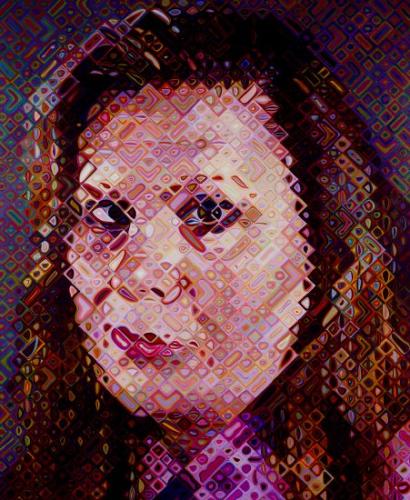Chuck Close
dal 29/1/2003 al 15/3/2003
Segnalato da
29/1/2003
Chuck Close
White Cube, London
Recent Paintings. White Cube is pleased to present a new group of paintings by acclaimed American artist Chuck Close. The paintings in this exhibition are both monumental and classical in their bold simplicity as well as intangible, appearing as if they have been viewed through a thick layer of glass or rippling on the surface of water.

Recent Paintings
White Cube is pleased to present a new group of paintings by acclaimed American artist Chuck Close. Since the late 1960s Close has been concentrating on portraiture and on the physiological make up of the human face through painting and photography. Close often takes his family and friends as models and these six recent portraits, dating from 2000-2002, include pictures of the artist's wife Leslie, fellow artists James Siena and Robert Rauschenberg as well as a new, scrutinising self-portrait. Although Close has worked through various painterly styles including an intense neo-realism in the 1970s and a shadowy pointillisme in the 1980s created by paint applied on the fingertips, he is perhaps best known for his more recent works, made up from a shimmering, fragile grid set on the diagonal. His method of painting is always indexical, an incremental process whereby associative colours and shapes build up a pictorial syntax and recognisable figurative whole.
The paintings in this exhibition are both monumental and classical in their bold simplicity as well as intangible, appearing as if they have been viewed through a thick layer of glass or rippling on the surface of water. 'Paul IV' (2001) a portrait of Paul Cadmus in profile, for example, is reminiscent of Holbein, but Close's works equally have the studied quality of Vermeer, where the liquid eyes and imprecise gaze of his sitters, fixes and absorbs the viewer at the same time.
Close's paintings are over-all images where the background of the picture - the negative space - is as important as the face itself, one cannot exist without the other. The backgrounds define both the limit of the picture plane and the outline of the sitter - in his daguerreotype photographs the inky pitch black sets off the light, reflective quality of the face and in his paintings the face is actually created through the interaction between light and shadow, foreground and background. Close employs a palette which, in these recent portraits, consists principally of murky flesh tones - a spectrum ranging from pale pink and peach through magentas and crimson, overlaid with darker tones of grey, blue and brown. In this way, the subjects of his paintings appear like apparitions, dissolving and resolving when viewed from changing distances.
In 'Self-Portrait' (2000), for example, the edges of the artist's face disintegrate at its outer limits by dark shapes, which are punctuated by occasional patches of light. On close examination, we are drawn to focus on the strange, even alarming clarity of the droplet shaped patch of bright white, marking the side of his nose, or at the teardrop shaped patch of white in his left eye. Likewise, in Close's portrait of the artist James Siena, 'James' (2002), the eyes are made up of dark quarter circles, making them seem both the focal point of the painting and yet also vortexes, constantly making the viewer adjust their gaze. 'Emma' (2000) a portrait of a young child, is suspended in animation, the skewed position of her head suggestive of expressive movement.
Close works on his paintings methodically, starting his loose but regular grid from the left hand corner of the canvas. Within this confining structure however, figuration is pushed to the extreme by an internal dynamic built up through a relationship of part to whole. Close's paintings seem intensely personal, his subjects inescapably rendered in character, but constantly shifting in their physical presence, through the palpable, distinct tension of both palette and form. Warm colours are set against cold, circles against squares and the organising principles of the grid constantly broken by minute areas of expressive abstraction. The paintings are supremely layered, but all the layers remain on the surface to create a rich tableaux of shapes, colours and tones jostling against each other forming a coherent but barely visible whole.
Chuck Close has exhibited in solo and group exhibitions internationally, including a major retrospective at the Walker Art Center, Minneapolis (1980) that also travelled to four venues including the Whitney Museum of American Art, New York. Close has also participated in other major exhibitions such as Documenta V and VI (1972 and 1977) and the Carnegie International (1995). In 1998, The Museum of Modern Art, New York, organized a retrospective that travelled to four venues closing at the Hayward gallery, London in 1999.
An illustrated catalogue will be available during the exhibition.
Opening Thursday 30th January 6-8pm
Open Tuesday to Saturday 10am - 6pm.
For further information please contact Susannah Hyman or Honey Luard on 020 7930 5373.
White Cube, 48 Hoxton Square, London N1 6PB



